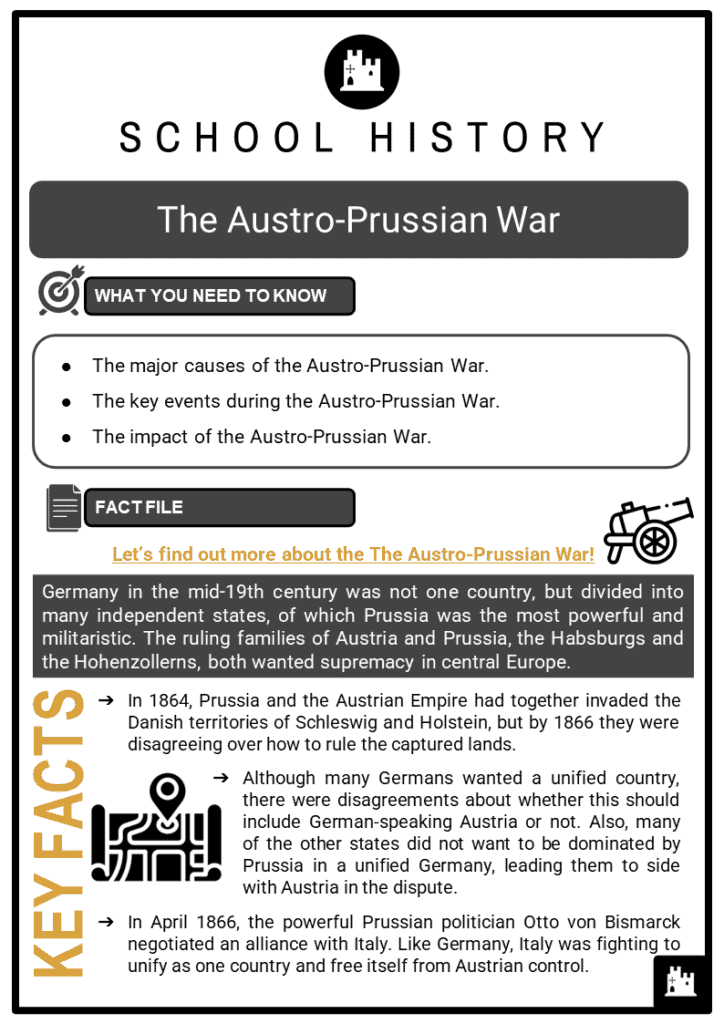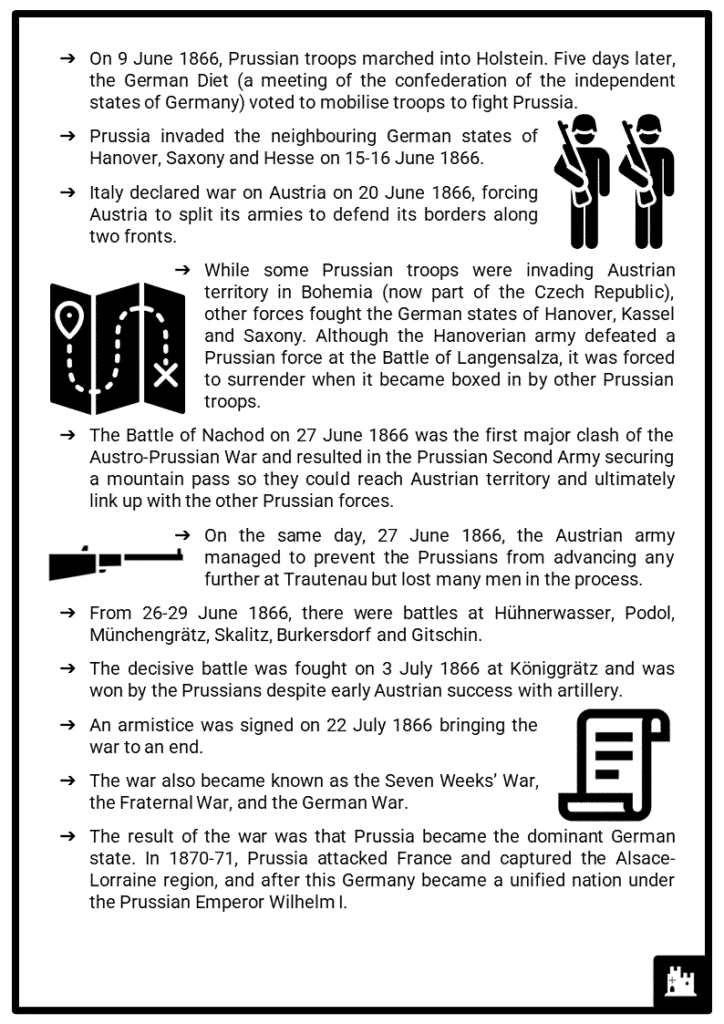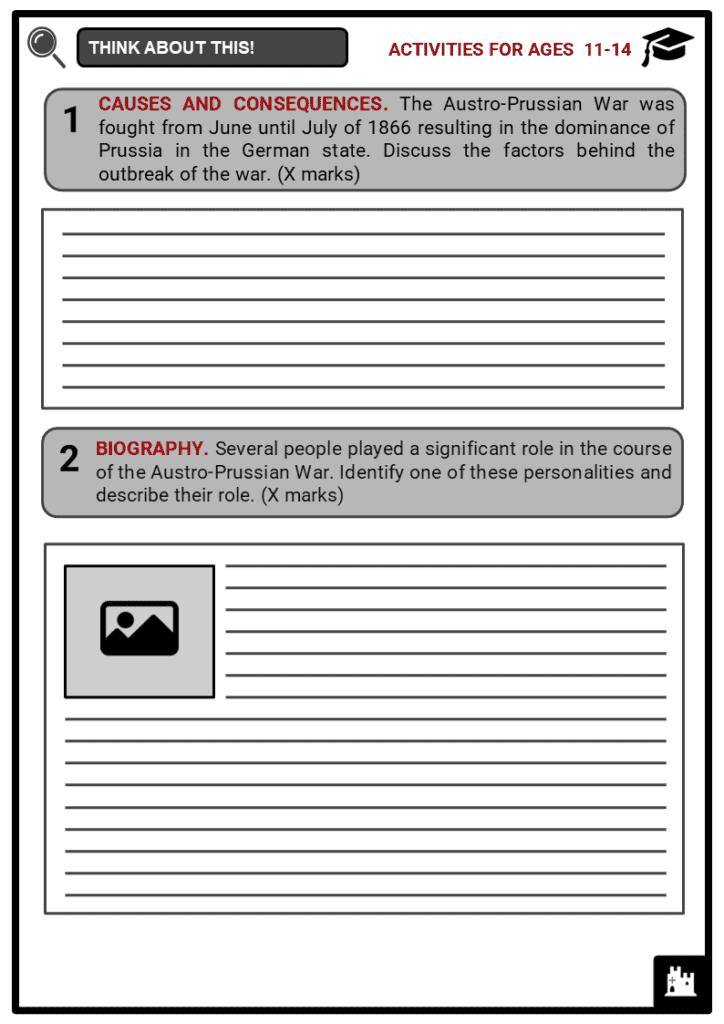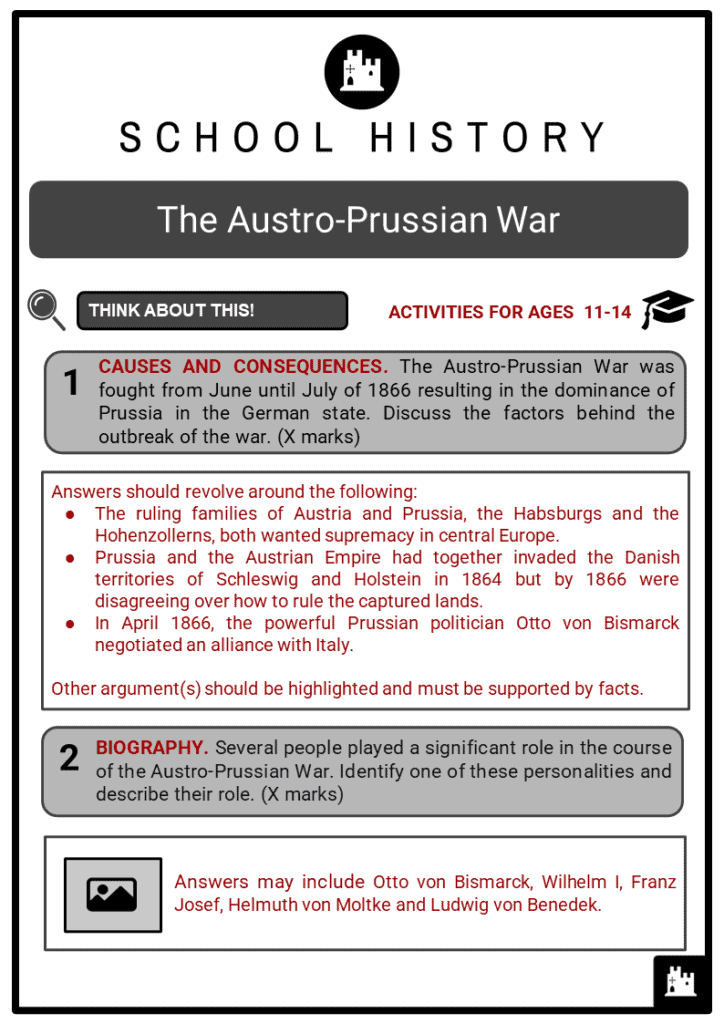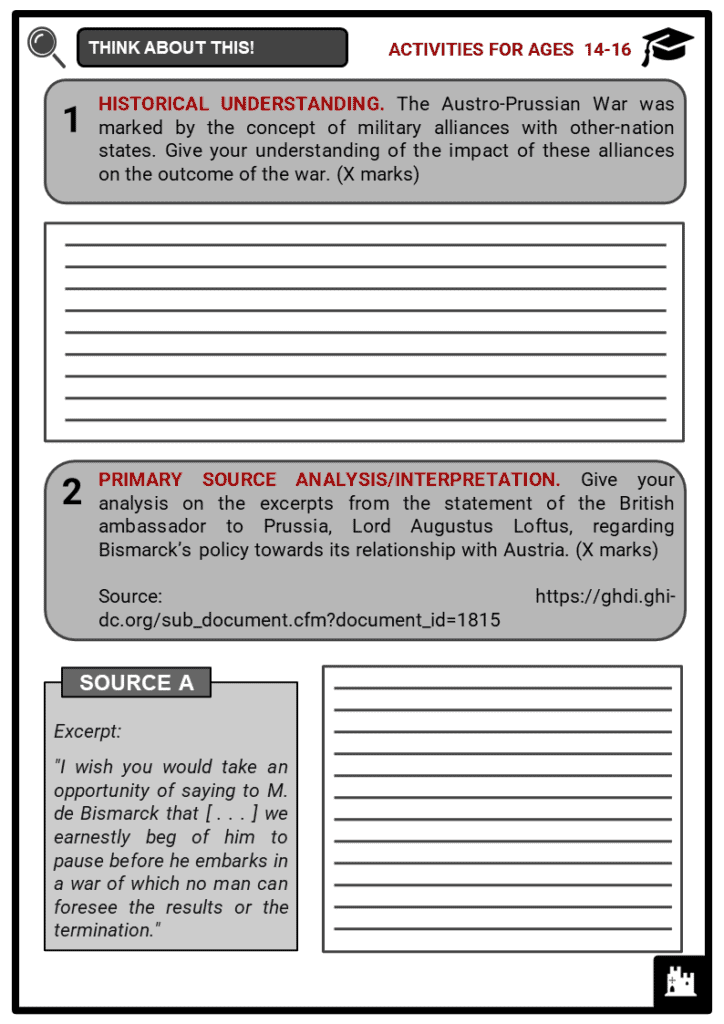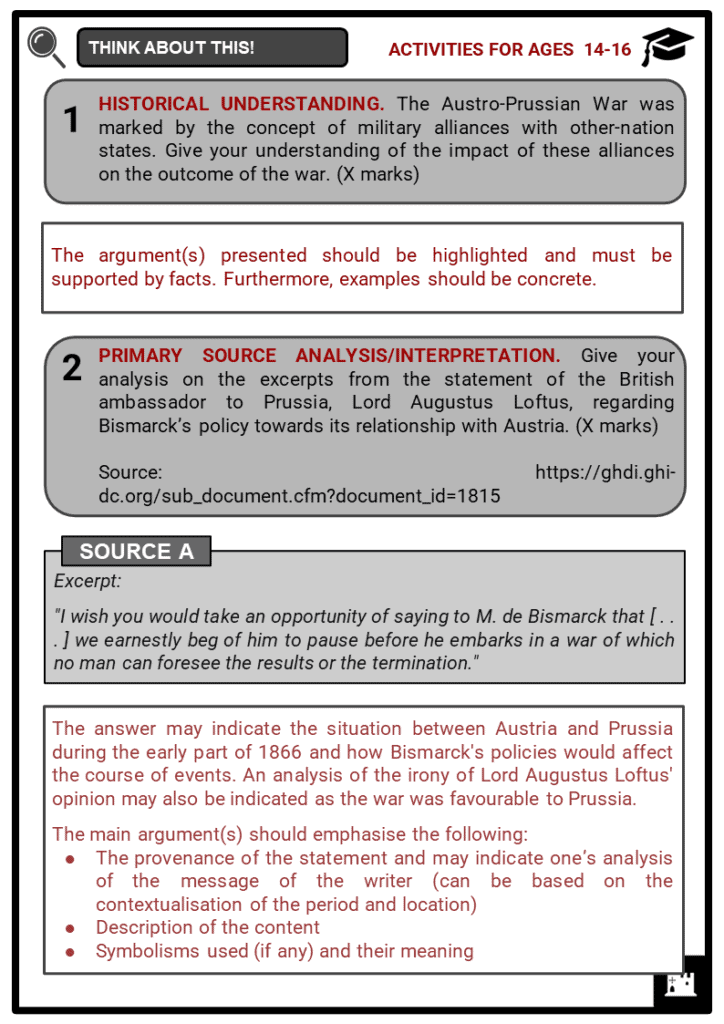Download The Austro-Prussian War Worksheets
Do you want to save dozens of hours in time? Get your evenings and weekends back? Be able to teach The Austro-Prussian War to your students?
Our worksheet bundle includes a fact file and printable worksheets and student activities. Perfect for both the classroom and homeschooling!
Table of Contents
Add a header to begin generating the table of contents
Summary
- The major causes of the Austro-Prussian War.
- The key events during the Austro-Prussian War.
- The impact of the Austro-Prussian War.
Key Facts And Information
Let’s find out more about the The Austro-Prussian War!
- Germany in the mid-19th century was not one country, but divided into many independent states, of which Prussia was the most powerful and militaristic. The ruling families of Austria and Prussia, the Habsburgs and the Hohenzollerns, both wanted supremacy in central Europe.
- In 1864, Prussia and the Austrian Empire had together invaded the Danish territories of Schleswig and Holstein, but by 1866 they were disagreeing over how to rule the captured lands.
- Although many Germans wanted a unified country, there were disagreements about whether this should include German-speaking Austria or not. Also, many of the other states did not want to be dominated by Prussia in a unified Germany, leading them to side with Austria in the dispute.
- In April 1866, the powerful Prussian politician Otto von Bismarck negotiated an alliance with Italy. Like Germany, Italy was fighting to unify as one country and free itself from Austrian control.
- On 9 June 1866, Prussian troops marched into Holstein. Five days later, the German Diet (a meeting of the confederation of the independent states of Germany) voted to mobilise troops to fight Prussia.
- Prussia invaded the neighbouring German states of Hanover, Saxony and Hesse on 15-16 June 1866.
- Italy declared war on Austria on 20 June 1866, forcing Austria to split its armies to defend its borders along two fronts.
- While some Prussian troops were invading Austrian territory in Bohemia (now part of the Czech Republic), other forces fought the German states of Hanover, Kassel and Saxony. Although the Hanoverian army defeated a Prussian force at the Battle of Langensalza, it was forced to surrender when it became boxed in by other Prussian troops.
- The Battle of Nachod on 27 June 1866 was the first major clash of the Austro-Prussian War and resulted in the Prussian Second Army securing a mountain pass so they could reach Austrian territory and ultimately link up with the other Prussian forces.
- On the same day, 27 June 1866, the Austrian army managed to prevent the Prussians from advancing any further at Trautenau but lost many men in the process.
- From 26-29 June 1866, there were battles at Hühnerwasser, Podol, Münchengrätz, Skalitz, Burkersdorf and Gitschin.
- The decisive battle was fought on 3 July 1866 at Königgrätz and was won by the Prussians despite early Austrian success with artillery.
- An armistice was signed on 22 July 1866 bringing the war to an end.
- The war also became known as the Seven Weeks’ War, the Fraternal War, and the German War.
- The result of the war was that Prussia became the dominant German state. In 1870-71, Prussia attacked France and captured the Alsace-Lorraine region, and after this Germany became a unified nation under the Prussian Emperor Wilhelm I.
Historical Context
- In the middle of the 19th century, Germany was not a unified country, but a group of individual states belonging to a confederation. The dominant powers in this organisation were Austria and Prussia.
- Austria was ruled by Emperors of the Habsburg dynasty, while Prussia was a kingdom ruled by the Hohenzollern family. Although Austria had been the leading power in Central Europe for some time, Prussia was a state on the rise, growing in wealth and military strength. It had conscription for its army, meaning that there was always a force of well-trained soldiers to call on, and could arm itself with the latest in modern weaponry thanks to the industrialist and manufacturer Alfred Krupp.
- In 1864, the two states had led an invasion of the Danish territory of Schleswig-Holstein. This war had been the first sign of the failure of the plan of Britain’s Queen Victoria and Prince Albert to bring peace to Europe by marrying their children into various royal families. Their eldest daughter was married to a Prussian prince and their eldest son to a Danish princess, but this did not stop the two countries from going to war against each other.
- By 1866, Austria and Prussia had reached a stalemate over how their new Danish territory should be governed. Prussia saw the dispute as an opportunity to become the dominant power in the German Confederation and began preparing for war with Austria. The Prussian Minister-President (prime minister), Otto von Bismarck, brokered an alliance with Italy, a country also seeking to throw off Austrian control, so that the Austrians would have to fight on two fronts at the same time, splitting the strength of its armies.
The War
- Prussia, Austria and Italy spent the spring of 1866 preparing their armies. Prussia’s mobilisation plans were drawn up by General Helmuth von Moltke, who was at the forefront of using modern innovations like railways and the telegraph to get troops quickly to where they were most needed. Rapid action was needed to overcome Prussia’s various opponents – not only would they be facing Austria, but also several of the other German states who were allied with Austria due to their fear of Prussian dominance.
- On 15-16 June 1866, Prussia invaded the neighbouring states of Hanover, Saxony and Hesse, all allies of Austria. They aimed to quickly force those states to surrender so that their manpower could not be used by Austria. On 20 June, Italy also declared war on Austria. By 27 June, Prussia suffered defeat to Hanover at the Battle of Langensalza, but the presence of other Prussian troops in the area meant that the Hanoverians were surrounded and forced to surrender anyway.
- While the campaign against the German states continued, three Prussian armies marched to face the Austrians in Bohemia (then in the Austrian Empire, now in the Czech Republic). The Army of the Elbe and the First Army fought and won minor battles on 26 June, which enabled them to cross the River Iser north of Prague and link up. The third Prussian Force, Second Army, was involved in a tough battle at Trautenau on 27 June to try and gain control of a mountain pass to cross into Austrian territory.
- Although the Austrians managed to push the Prussians back, they lost thousands of men in the process, and later in the day, the Prussians were able to force an Austrian retreat elsewhere, at Nachod, and secure a different route through the mountains. All three Prussian armies were now in Austrian territory. The Austrians’ best chance of victory depended on them being able to face the Prussians separately before they had the chance to unite as one force.
- Over the next few days, there were various battles as the Austrians retreated and the Prussians advanced. All resulted in Prussian victories. The Austrian commander, Ludwig von Benedek, decided to move his troops back to the town of Königgrätz, and on 1 July 1866, he sent a message to the Austrian Emperor, Franz Josef, to ask him to negotiate peace to avoid catastrophe for his army. The emperor refused, and Benedek felt he had no choice but to make a stand.
- The Prussians had lost contact with the Austrians for a time, but Moltke correctly guessed that they would reorganise on the east bank of the River Elbe near Königgrätz. He received confirmation of this late on 2 July and planned to attack the next day with two of his armies, hoping that the last one, the Second Army, would be able to arrive at some point during the battle.
- The battle of Königgrätz on 3 July 1866 was the decisive clash of the Austro-Prussian War. At the start of the day, the Prussian Second Army had not arrived, and the Army of the Elbe was held up crossing the river, meaning that the First Army had to take on the bulk of the early fighting.
- Although heavily outnumbered, the First Army was able to hold the Austrians off. A lot of the battle took place in the Swiepwald, forest terrain offering good cover for the Prussians to reload their rapid-fire needle guns and pick off the advancing enemy. The Austrians were armed with rifles that needed to be reloaded via the muzzle, in a standing position, leaving them exposed during the reloading process.
- The Peace of Prague was officially signed on 23 August 1866. It marked the end of the idea that Austria would be part of a unified Germany and gave Prussia total dominance in the region. The defeat of Austria and the other German states which had opposed it enabled Prussia to turn its attention to France, which it defeated in the war of 1870-71 to gain control of Alsace-Lorraine. In the aftermath of this war, Germany was officially unified under Emperor Wilhelm I, the Prussian king.
Impact
- In the mid-19th century, the German-speaking people of Europe lived in many different states, the most powerful of which were Austria and Prussia. These two states both wanted to take the leading role in the German Confederation, and this power struggle led to the Austro-Prussian War, fought over just a few weeks in the summer of 1866.
- The other German states were split; some allied with the Austrians while others allied with Prussia. At the same time, Italy, an ally of Prussia, also fought a war against Austria to regain control of the Venetia region.
- Prussian forces divided so that they could take on all their enemies almost simultaneously before they could unite into larger fighting forces. While some Prussian armies remained in German territory to fight other states like Hanover and Bavaria, others were sent to Bohemia, part of the Austrian Empire, to take the fight to the Austrians. Masterminding the movement of the armies was the forward-thinking Prussian Chief of Staff Helmuth von Moltke.
- He used railways and telegraph communication to deploy the troops as quickly and effectively as possible. The Prussians also benefitted from modern weaponry like the rapid-fire needle gun, which could be reloaded while lying on the ground, making the soldiers less vulnerable to enemy attack.
- Although the Prussians were defeated by the Hanoverians at the Battle of Langensalza and by the Austrians at the Battle of Trautenau, they won a victory in every other clash of the war. The decisive battle came at Königgrätz on 3 July 1866. The Prussians defeated the more numerous Austrians and pushed them back towards Vienna, forcing them to sue for peace. The peace treaty gave Prussia total dominance over the other German states, and within just a few years Germany was unified as one country, under Emperor Wilhelm I. The power of Austria and its Habsburg dynasty was significantly reduced, as it was not only forced to give up its dominance of German-speaking people but also had to hand over the Venetia region to the Italians.
Image sources:

